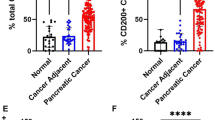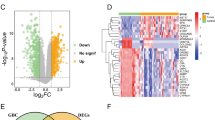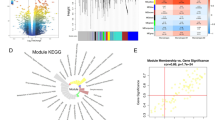Abstract
Lymph node metastasis (LNM) is recognised as an important factor involved in malignant tumour progression by interfering with a favourable prognosis. It is involved in a variety of cancers. Proteins are believed to play important roles in the LNM of cancers. The rapid achievements of state-of-the-art proteomic techniques have emerged as the key technologies successfully applied to identify markers for cancers at high-throughput level by providing novel targets and creating possible therapeutic interventions in cancer research. This review summarises recent progress in proteomic research in hepatocarcinoma, gastric cancer, oesophageal cancer, colorectal cancer, breast cancer, lung cancer and nasopharyngeal cancer. Actin, heat-shock proteins (HSPs), annexins, cytokeratin 10 (CK10), CK19, protein gene product 9.5 (PGP9.5) and protein disulfide isomerase (PDI) are the most common proteins in lymphatic metastases of cancers revealed by proteomic and protein functional studies. Other protein candidates specifically associated with LNMs of certain cancers are also summarised and discussed.
Similar content being viewed by others
References
Yokota J (2000) Tumor progression and metastasis. Carcinogenesis 21:497–503
Liu S, Sun MZ, Tang JW et al (2008) Highperformance liquid chromatography/nano-electrospray ionization tandem mass spectrometry, two-dimensional difference in-gel electrophoresis and gene microarray identification of lymphatic metastasis-associated biomarkers. Rapid Commun Mass Spectrom 22:3172–3178
Pepper M (2001) Lymphangiogenesis and tumor metastasis. Clin Cancer Res 7:462–468
Wang C, Lin K, Chen S et al (2004) Overexpression of SPARC gene in human gastric carcinoma and its clinicopathologic significance. Br J Cancer 91:1924–1930
Parkin DM, Bray F, Ferlay J et al (2005) Global cancer statistics, 2002. CA Cancer J Clin 55:74–108
Llovet JM, Burroughs A, Bruix J (2003) Hepatocellular carcinoma. Lancet 362:1907–1917
Hou L, Li Y, Jia YH et al (2001) Molecular mechanism about lymphogenous metastasis of hepatocarcinoma cells in mice. World J Gastroenterol 7:532–536
Sun MZ, Liu S, Tang J et al (2009) Proteomics analysis of two mice hepatocarcinoma ascites syngeneic cell lines with high and low lymph node metastasis rates provide potential protein markers for tumor malignancy attributes to lymphatic metastasis. Proteomics 9:3285–3302
Miyoshi Y, Nakayama S, Torikoshi Y et al (2006) High expression of ubiquitin carboxy-terminal hydrolase-L1 and -L3 mRNA predicts early recurrence in patients with invasive breast cancer. Cancer Sci 97:523–529
Myung JK, Afjehi-Sadat L, Felizardo-Cabatic M et al (2004) Expressional patterns of chaperones in ten human tumor cell lines. Proteome Sci 2:8
Chen N, Sun W, Deng X et al (2008) Quantitative proteome analysis of HCC cell lines with different metastatic potentials by SILAC. Proteomics 8:5108–5118
Luu-The V, Tremblay P, Labrie F (2006) Characterization of type 12 17beta-hydroxysteroid dehydrogenase, an isoform of type 3 17beta-hydroxysteroid dehydrogenase responsible for estradiol formation in women. Mol Endocrinol 20:437–443
Jansson A, Carlsson J, Olsson A et al (2007) A new polymorphism in the coding region of exon four in HSD17B2 in relation to risk of sporadic and hereditary breast cancer. Breast Cancer Res Treat 106:57–64
Panet R, Marcus Matlan H (2000) Overexpression of the Na(+)/K(+)/Cl(-) cotransporter gene induces cell proliferation and phenotypic transformation in mouse fibroblasts. J Cell Physiol 182: 109–118
Gumireddy K, Sun F, Klein-Szanto AJ et al (2007) In vivo selection for metastasis promoting genes in the mouse. Proc Natl Acad Sci U S A 104: 6696–6701
Yang XR, Xu Y, Shi GM et al (2008) Cytokeratin 10 and cytokeratin 19: predictive markers for poor prognosis in hepatocellular carcinoma patients after curative resection. Clin Cancer Res 14:3850–3859
Hsu YC, Fu HH, Jeng YM et al (2006) Prolinedirected protein kinase FA is a powerful and independent prognostic predictor for progression and patient survival of hepatocellular carcinoma. J Clin Oncol 24:3780–3788
Park JH, Koh KC, Choi MS et al (2006) Analysis of risk factors associated with early multinodular recurrences after hepatic resection for hepatocellular carcinoma. Am J Surg 192:29–33
Zhuang PY, Zhang JB, Zhu XD et al (2008) Two pathologic types of hepatocellular carcinoma with lymph node metastasis with distinct prognosis on the basis of CK19 expression in tumor. Cancer 112:2740–2748
Corcelle V, Stieger B, Gjinovci A et al (2006) Characterization of two distinct liver progenitor cell subpopulations of hematopoietic and hepatic origins. Exp Cell Res 312:2826–2836
Roskams T (2006) Liver stem cells and their implication in hepatocellular and cholangiocarcinoma. Oncogene 25:3818–3822
Yi X, Luk JM, Lee NP et al (2008) Association of mortalin (HSPA9) with liver cancer metastasis and prediction for early tumor recurrence. Mol Cell Proteomics 7:315–325
Dai Z, Zhou J, Li X-f et al (2007) An analysis of annexin II related to HCC metastatic ability. Chin J Hepatol 15:563–566
Guo K, Liu Y, Zhou H et al (2008) Involvement of protein kinase C beta-extracellular signal-regulating kinase 1/2/p38 mitogen-activated protein kinase-heat shock protein 27 activation in hepatocellular carcinoma cell motility and invasion. Cancer Sci 99:486–496
Li L, Chen SH, Yu CH et al (2008) Identification of hepatocellular-carcinoma-associated antigens and autoantibodies by serological proteome analysis combined with protein microarray. J Proteome Res 7:611–620
Lee NP, Leung KW, Cheung N et al (2008) Comparative proteomic analysis of mouse livers from embryo to adult reveals an association with progression of hepatocellular carcinoma. Proteomics 8:2136–2149
Liu LX, Lee NP, Chan VW et al (2009) Targeting cadherin-17 inactivates Wnt signaling and inhibits tumor growth in liver carcinoma. Hepatology 50: 1453–1463
Chen J, Kahne T, Rocken C et al (2004) Proteome analysis of gastric cancer metastasis by two-dimensional gel electrophoresis and matrix assisted laser desorption/ionization-mass spectrometry for identification of metastasis-related proteins. J Proteome Res 3:1009–1016
Concannon CG, Gorman AM, Samali A (2003) On the role of Hsp27 in regulating apoptosis. Apoptosis 8:61–70
Pei H, Zhu H, Zeng S et al (2007) Proteome analysis and tissue microarray for profiling protein markers associated with lymph node metastasis in colorectal cancer. J Proteome Res 6:2495–2501
Tian T, Hao J, Xu A et al (2007) Determination of metastasis-associated proteins in non-small cell lung cancer by comparative proteomic analysis. Cancer Sci 98:1265–1274
Babbin BA, Lee WY, Parkos CA et al (2006) Annexin I regulates SKCO-15 cell invasion by signaling through formyl peptide receptors. J Biol Chem 281:19588–19599
Yao H, Zhang ZX, Chen Y et al (2009) Identification of metastasis associated proteins in human lung squamous carcinoma using two-dimensional difference gel electrophoresis and laser capture microdissection. Lung Cancer 65:41–48
Dawling S, Roodi N, Mernaugh RL et al (2001) Catechol-O-methyltransferase (COMT)-mediated metabolism of catechol estrogens: comparison of wild-type and variant COMT isoforms. Cancer Res 61:6716–6722
Chen CD, Wang CS, Huang YH et al (2007) Overexpression of CLIC1 in human gastric carcinoma and its clinicopathological significance. Proteomics 7:155–167
Valenzuela SM, Mazzanti M, Tonini R et al (2000) The nuclear chloride ion channel NCC27 is involved in regulation of the cell cycle. J Physiol 529:541–552
Huang JS, Chao CC, Su TL et al (2004) Diverse cellular transformation capability of overexpressed genes in human hepatocellular carcinoma. Biochem Biophys Res Commun 315: 950–958
Hatakeyama H, Kondo T, Fujii K et al (2006) Protein clusters associated with carcinogenesis, histological differentiation and nodal metastasis in esophageal cancer. Proteomics 6:6300–6316
Moumen A, Masterson P, O’Connor MJ et al (2005) hnRNP K: an HDM2 target and transcriptional coactivator of p53 in response to DNA damage. Cell 123:1065–1078
Mandal M, Vadlamudi R, Nguyen D et al (2001) Growth factors regulate heterogeneous nuclear ribonucleoprotein K expression and function. J Biol Chem 276:9699–9704
Ueno T, Tangoku A, Yoshino S et al (2002) Gain of 5p15 detected by comparative genomic hybridization as an independent marker of poor prognosis in patients with esophageal squamous cell carcinoma. Clin Cancer Res 8:526–533
Yasumatsu R, Nakashima T, Hirakawa N et al (2001) Maspin expression in stage I and II oral tongue squamous cell carcinoma. Head Neck 23: 962–966
Nishimori T, Tomonaga T, Matsushita K et al (2006) Proteomic analysis of primary esophageal squamous cell carcinoma reveals downregulation of a cell adhesion protein, periplakin. Proteomics 6:1011–1018
Mandelker DL, Yamashita K, Tokumaru Y et al (2005) PGP9.5 promoter methylation is an independent prognostic factor for esophageal squamous cell carcinoma. Cancer Res 65:4963–4968
Liu Y, Fallon L, Lashuel HA et al (2002) The UCH-L1 gene encodes two opposing enzymatic activities that affect alpha-synuclein degradation and Parkinson’s disease susceptibility. Cell 112:209–218
Harada T, Harada C, Wang YL et al (2004) Role of ubiquitin carboxy terminal hydrolase-L1 in neural cell apoptosis induced by ischemic retinal injury in vivo. Am J Pathol 164:59–64
Honda K, Yamada T, Hayashida Y et al (2005) Actinin-4 increases cell motility and promotes lymph node metastasis of colorectal cancer. Gastroenterology 128:51–62
Miyanishi K, Takayama T, Ohi M et al (2001) Glutathione S-transferase-pi overexpression is closely associated with K-ras mutation during human colon carcinogenesis. Gastroenterology 121: 865–874
Guzman-Aranguez A, Olmo N, Turnay J et al (2005) Differentiation of human colon adenocarcinoma cells alters the expression and intracellular localization of annexins A1, A2, and A5. J Cell Biochem 94:178–193
Lawrie LC, Dundas SR, Curran S et al (2004) Liver fatty acid binding protein expression in colorectal neoplasia. Br J Cancer 90:1955–1960
Lyall MS, Dundas SR, Curran S et al (2006) Pro-filing markers of prognosis in colorectal cancer. Clin Cancer Res 12:1184–1191
Ma Y, Zhao M, Zhong J et al (2010) Proteomic profiling of proteins associated with lymph node metastasis in colorectal cancer. J Cell Biochem 110:1512–1519
Kim HJ, Kim YM, Lim S et al (2009) Ubiquitin C-terminal hydrolase-L1 is a key regulator of tumor cell invasion and metastasis. Oncogene 28: 117–127
Brookes MJ, Hughes S, Turner FE et al (2006) Modulation of iron transport proteins in human colorectal carcinogenesis. Gut 55:1449–1460
Hu X, Zhang Y, Zhang A et al (2009) Comparative serum proteome analysis of human lymph node negative/positive invasive ductal carcinoma of the breast and benign breast disease controls via label-free semiquantitative shotgun technology. OMICS 13:291–300
Levy P, Ripoche H, Laurendeau I et al (2007) Microarray-based identification of tenascin C and tenascin XB, genes possibly involved in tumorigenesis associated with neurofibromatosis type 1. Clin Cancer Res 13:398–407
Matsumoto K, Takayama N, Ohnishi J et al (2001) Tumour invasion and metastasis are promoted in mice deficient in tenascin-X. Genes Cells 6:1101–1111
Hagan S, Al-Mulla F, Mallon E et al (2005) Reduction of Raf-1 kinase inhibitor protein expression correlates with breast cancer metastasis. Clin Cancer Res 11:7392–7397
Reddy KB, Nabha SM, Atanaskova N (2003) Role of MAP kinase in tumor progression and invasion. Cancer Metastasis Rev 22:395–403
Yeung KC, Rose DW, Dhillon AS et al (2001) Raf kinase inhibitor protein interacts with NF-kappaB-inducing kinase and TAK1 and inhibits NFkap-paB activation. Mol Cell Biol 21:7207–7217
Chatterjee D, Bai Y, Wang Z et al (2004) RKIP sensitizes prostate and breast cancer cells to druginduced apoptosis. J Biol Chem 279:17515–17523
Sun B, Zhang S, Zhang D et al (2008) Identification of metastasis-related proteins and their clinical relevance to triple-negative human breast cancer. Clin Cancer Res 14:7050–7059
Kluger HM, Chelouche Lev D, Kluger Y et al (2005) Using a xenograft model of human breast cancer metastasis to find genes associated with clinically aggressive disease. Cancer Res 65: 5578–5587
Kallergi G, Mavroudis D, Georgoulias V et al (2007) Phosphorylation of FAK, PI-3K, and impaired actin organization in CK-positive micrometastatic breast cancer cells. Mol Med 13:79–88
Heizmann CW, Fritz G, Schafer BW (2002) S100 proteins: structure, functions and pathology. Front Biosci 2:d1356–1368
Mori M, Shimada H, Gunji Y et al (2004) S100A11 gene identified by in-house cDNA microarray as an accurate predictor of lymph node metastases of gastric cancer. Oncol Rep 11:1287–1295
Song HY, Liu YK, Feng JT et al (2006) Proteomic analysis on metastasis-associated proteins of human hepatocellular carcinoma tissues. J Cancer Res Clin Oncol 132:92–98
Liu YF, Xiao ZQ, Li MX et al (2009) Quantitative proteome analysis reveals annexin A3 as a novel biomarker in lung adenocarcinoma. J Pathol 217:54–64
Wu W, Tang X, Hu W et al (2002) Identification and validation of metastasis-associated proteins in head and neck cancer cell lines by two-dimensional electrophoresis and mass spectrometry. Clin Exp Metastasis 19:319–326
Chan CM, Wong SC, Lam MY et al (2008) Proteomic comparison of nasopharyngeal cancer cell lines C666-1 and NP69 identifies down-regulation of annexin II and beta2-tubulin for nasopharyngeal carcinoma. Arch Pathol Lab Med 132:675–683
Park JE, Lee DH, Lee JA et al (2005) Annexin A3 is a potential angiogenic mediator. Biochem Biophys Res Commun 337:1283–1287
Li DJ, Deng G, Xiao ZQ et al (2009) Identificating 14-3-3 sigma as a lymph node metastasis-related protein in human lung squamous carcinoma. Cancer Lett 279:65–73
Lehnigk U, Zimmermann U, Woenckhaus C et al (2005) Localization of annexins I, II, IV and VII in whole prostate sections from radical prostatectomy patients. Histol Histopathol 20:673–680
Emoto K, Yamada Y, Sawada H et al (2001) Annexin II overexpression correlates with stromal tenascin-C overexpression: a prognostic marker in colorectal carcinoma. Cancer 92:1419–1426
Emoto K, Sawada H, Yamada Y et al (2001) Annexin II overexpression is correlated with poor prognosis in human gastric carcinoma. Anticancer Res 21:1339–1345
Zhou G, Zhai Y, Cui Y et al (2007) MDM2 promoter SNP309 is associated with risk of occurrence and advanced lymph node metastasis of nasopharyngeal carcinoma in Chinese population. Clin Cancer Res 13:2627
Cheng L, Zhou L, Tao L et al (2008) SELDI-TOF MS profiling of serum for detection of laryngeal squamous cell carcinoma and the progression to lymph node metastasis. J Cancer Res Clin Oncol 134:769–776
Liang L, Qu L, Ding Y (2007) Protein and mRNA characterization in human colorectal carcinoma cell lines with different metastatic potentials. Cancer Invest 25:427–434
Wang KL, Wu TT, Resetkova E et al (2006) Expression of annexin A1 in esophageal and esophagogastric junction adenocarcinomas: association with poor outcome. Clin Cancer Res 12:4598–4604
Author information
Authors and Affiliations
Corresponding authors
Rights and permissions
About this article
Cite this article
Zong, J., Guo, C., Liu, S. et al. Proteomic research progress in lymphatic metastases of cancers. Clin Transl Oncol 14, 21–30 (2012). https://doi.org/10.1007/s12094-012-0757-7
Received:
Accepted:
Published:
Issue Date:
DOI: https://doi.org/10.1007/s12094-012-0757-7




